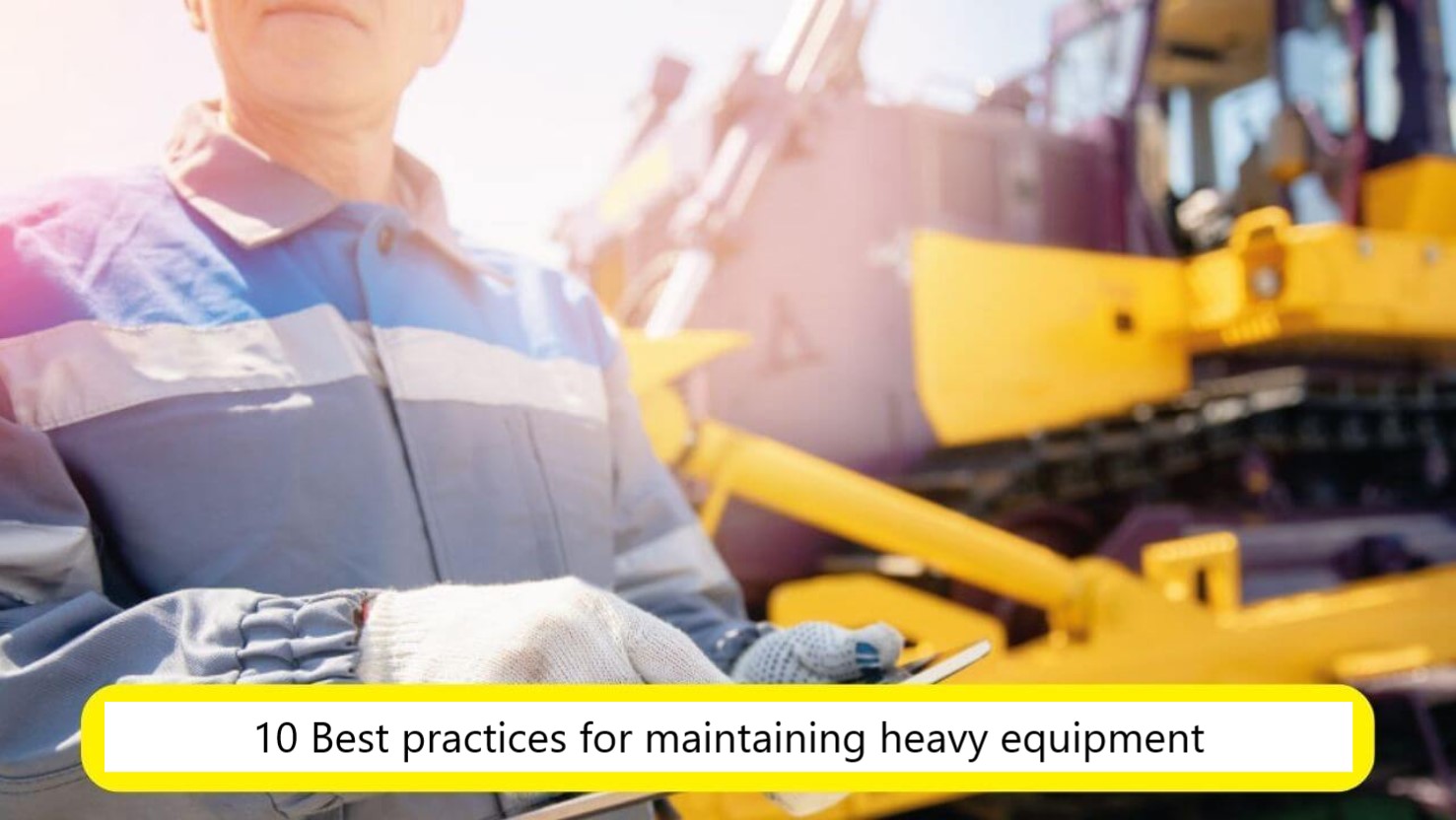10 Best practices for maintaining heavy equipment

Kworld Trend / 10 Best practices for maintaining heavy equipment, Tracking and Maintaining Your Construction Equipment to Standards Although it may seem daunting and time consuming, it is essential to reaching its full life potential, as well as saving time and money and helping to keep machine operators safe. .
It’s easy to let your hardware take care of itself, and once it’s damaged or broken, throw it away and replace it. However, regular maintenance and spending time on equipment will benefit you in many ways, and operators don’t like using a tired piece of equipment that no one can bother to maintain.
What is heavy equipment maintenance?
Heavy Equipment Service are the steps you take to identify, repair and prevent problems with your equipment. In general, heavy equipment maintenance will include checking, repairing, and cleaning your company’s machinery.
You can divide maintenance into two different categories: preventive maintenance and reactive maintenance. Preventive maintenance includes scheduled tasks intended to keep your equipment running at its best. Some common examples include checking tire pressure, routine cleaning, and oil changes.
In contrast, reactive maintenance occurs after a problem has occurred, for example when a piece of equipment does not work as it is supposed to or fails completely. Reactive maintenance mainly involves fixing problems after they occur, while preventive maintenance is about preventing problems from occurring in the first place.
Heavy equipment maintenance tips
When you want to know how to maintain heavy equipment, you may want to check out some of the tips experienced companies use to ensure construction equipment doesn’t break down unexpectedly or slow down. From scheduling regular maintenance and fluid checks to training operators and cleaning regularly, there are many things you can do to take care of your machines. To better maintain your equipment, follow these heavy equipment service tips:
1. Schedule regular maintenance
Scheduling regular maintenance is one of the first steps you can take to avoid downtime caused by not maintaining your equipment. Instead of performing maintenance when there is a problem or when you remember to do it, you can add it to your company’s schedule to make sure everyone knows when they have to service heavy equipment.
Scheduled maintenance should revolve around the equipment manufacturer’s recommendations. Manufacturers have details about maintenance best practices associated with their equipment, and it’s a good idea to use these recommendations as you create your own maintenance schedule.
2. Training of operators on the proper use of machines
When you train your operators on how to properly use your company’s machinery, you reduce the chances that they will engage in practices that will damage equipment. An operator who is not properly trained will often push a piece of equipment beyond its limits or use it for a task for which it was not designed, resulting in damage to the equipment. Appropriate use of machines prevents accidents and other damages that may require companies to perform additional maintenance on their equipment.
Training can also include information on how to identify common maintenance problems and proper machine inspection. When operators are trained to perform safety check checks, they can ensure that the machine is safe to use. Operators who know more about their equipment can also identify potential maintenance issues through visual cues, performance issues, and strange sounds. By detecting problems instantly, operators can keep your equipment running at peak performance and make repairs when needed.
3. Maintain documentation of repairs and services
Having a clear record of what maintenance has been done is essential to taking care of your equipment. Knowing what repairs were made and which didn’t, can give you an idea of what you might need to fix soon. A long history of repairs and services can also help you identify equipment that is ready to be retired and replaced with something more reliable.
4. Check fluids
Maintaining fluids at the proper quality and level is critical to the maintenance of construction equipment. When you neglect your fluids, you run the risk of increased wear on machine components and not running your machines efficiently. Make sure your liquids are filled to the exact specifications. For example, filling transmission fluid into a machine can cause it to overheat.
Another important area to check is whether your equipment is properly lubricated. If you want heavy equipment maintenance to keep everything running smoothly, you need to properly lubricate key components. Be sure to check the manufacturer’s recommendations for the amount of lubricant to use, ensuring that you don’t use too little or too much.
Oil is one of the main fluids you have to keep an eye on, as its quality can affect how long your equipment will run adequately. Look for contaminants in the oil to ensure that the quality has not been affected. Keep the oil at the proper level, and change the oil at recommended intervals.
5. Consider the environment of the device
Where you store and use your device is important. Weather elements such as mud, snow, freezing temperatures, and extreme heat can affect your device and require different maintenance requirements. Companies operating in harsh environmental conditions where more stress is placed on equipment must perform maintenance and inspections more often than if they were operating in moderate conditions. 10 Best practices for maintaining heavy equipment
6. Use checklists
One of the main tips for maintaining construction equipment is to create checklists of the appropriate inspection and maintenance steps that team members should take when they evaluate a piece of machinery. Creating checklists for each piece of equipment can help your service personnel thoroughly check your equipment and repair it appropriately. By giving workers a checklist, you reduce the chances of employees missing anything in an inspection or repair.
7. Ask for customer value agreements
If you want to take your equipment maintenance to the next level, you may want to ask your supplier for a Customer Value Agreement (CVA) . When a piece of equipment needs repair or reaches a point where a piece needs to be replaced, CVA ensures that the parts are delivered to you quickly with instructions on how to properly perform the maintenance. The agreement also ensures that you will never fall behind in servicing your equipment and helps you stay on the best maintenance schedule for your equipment.
8. Use Genuine Cat parts
For companies that use Cat equipment, Genuine Cat parts are an essential component of good. Maintenance practices. These parts are designed for Cat equipment and are of the highest quality. Ensuring that your machine runs on reliable parts. Genuine Cat parts also provide tighter tolerances and a lower cost per hour. If you use Cat equipment, the benefits of Genuine Cat parts make them an essential component of any quality maintenance program.
9. Clean regularly
Cleaning is not just about improving the aesthetic appearance of your equipment. While keeping your equipment looking good is great for your company’s efficiency. Cleaning is also an excellent opportunity for workers to check for signs of damage or other problems. When team members clean your equipment, they should be trained to spot damage and have checklists to follow as they complete the process.
10. Use technology to your advantage
Take advantage of the latest technology available for better maintenance of your heavy equipment. Start using smartphones and tablets to store checklists with Cat Inspect. To help workers take notes and give employees an easy way to contact each other for advice. These devices also make it easier for employees to access information. As tablets or smartphones give workers a digital copy of checklists and other documents. Instead of searching for physical versions of major maintenance documents. The worker can access the required information anytime and anywhere.
Conclusion
Construction equipment maintenance is a vital aspect of managing heavy machinery in the construction industry.
By implementing maintenance best practices, construction companies can achieve many benefits. Including: increased equipment life, enhanced safety, reduced downtime, improved equipment performance, cost savings, and compliance with manufacturer guidelines.
By adhering to best practices for maintenance of construction equipment. Companies can improve their operations, improve safety, and achieve better returns on their equipment investment.
Prioritizing regular inspections, preventive maintenance, and operator training ensures. That construction equipment remains reliable, efficient. And able to meet the demands of challenging construction projects. 10 Best practices for maintaining heavy equipment





